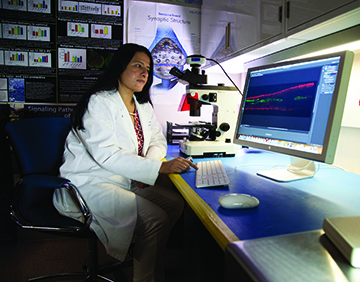The spinal cord can be injured in many ways. Car accidents, falls, violence, and sports are the four leading causes of traumatic spinal cord injury (SCI). Regardless of the cause, the resulting damage to the spinal cord develops in a similar way and it’s important to take steps at reducing damage following spinal cord injury. The first phase is called the “primary injury” and is caused by the sudden blow that fractures, dislocates, or compresses the bones of the spine (vertebrae). Additional damage occurs due to bleeding, activation of the immune system (inflammation), and fluid accumulation in and around the spinal cord. This “second injury” can last for a period of time between several days to weeks. Decreased blood flow, inflammation, and increased production of destructive molecules (free radicals) leads to an environment of oxidative stress, which triggers a chain reaction resulting in more cell death in the spinal cord and ultimately more loss of function.
One particular enzyme that is expressed by cells in response to cell damage and inflammation is called inducible nitric oxide synthase (iNOS). iNOS contributes to a high production of nitric oxide (NO). NO, while being an important molecule involved in regulating many different processes in the body, when produced at high levels following injury leads to the formation of many free radicals and results in significant cell death. Researchers at The Miami Project hypothesized that blocking the action of iNOS after spinal cord injury would reduce levels of NO, and therefore result in less free radical production and cell death, reducing damage following spinal cord injury, as well as leading to better functional outcomes. Experiments confirmed that fewer cells died around the area of injury when animals were treated with iNOS-blocking drugs and that these animals performed better in some locomotor tests (Maggio et al., 2012). However, these experiments only blocked the action of iNOS for a few days, in the acute time period after spinal cord injury. Drs. Pearse, Dietrich, Ghosh and their collaborators wondered whether a longer-term inhibition of iNOS would produce better results. Although iNOS and NO are involved in processes that cause cell death immediately after injury, they are also involved in the processes of wound healing and repair. In order to understand whether blocking iNOS for longer periods of time would lead to even greater recovery, the team designed new experiments.
A transgenic mouse model in which iNOS was “knocked out” was used; mice were specially bred to have a complete and permanent loss of the iNOS enzyme after spinal cord injury. Two weeks after injury, the iNOS knockout mice exhibited a more rapid and significant improvement in walking function, which continued until four weeks post-injury. However, six weeks after injury, the mice missing iNOS did not perform any better than regular “non-knockout”, control mice. In addition, the iNOS knockout mice actually had LESS preserved white and gray matter, and fewer axons and blood vessels compared to controls (Maggio et al., 2017).
So the process is not simply black and white. In the short term, blocking the actions of iNOS results in more preserved tissue and improved function. However, in the long term, knocking out iNOS seems to have negative effects, by blocking protective or reparative processes that are important for the formation of new blood vessels and preserving tissue. These results will help scientists identify the optimal duration of time that iNOS should be blocked in order to produce the best outcomes after SCI.
Articles – Dominic M. Maggio, Amanpreet Singh, J. Bryan Iorgulescu, Drew H. Bleicher, Mousumi Ghosh,
Michael M. Lopez, Luis M. Tuesta, Govinder Flora, W. Dalton Dietrich, Damien D Pearse. (2017).
Identifying the long-term role of inducible nitric oxide synthase after contusive spinal cord injury using a transgenic mouse model. International Journal of Molecular Sciences 18
Dominic M. Maggio, Katina Chatzipanteli, Neil Masters, Samik P. Patel, W. Dalton Dietrich, Damien D. Pearse. (2012). Acute molecular perturbation of inducible nitric oxide synthase with an antisense approach enhances neuronal preservation and functional recovery after contusive spinal cord injury. Journal of Neurotrauma 29(12): 2244-2249

